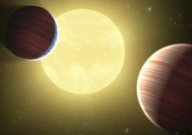Space & Astronomy
February 28, 2011 · 32 comments
32 comments

Image Credit: NASA
Source: New Scientist | Comments (32)
Two planets discovered sharing one orbit
By T.K. RandallFebruary 28, 2011 ·
 32 comments
32 comments
Image Credit: NASA
Kepler has found something unlike anything seen before - two planets sharing the same orbit.
The two planets orbit their parent star every 9.8 days but don't collide because one is 60 degrees ahead of the other. The discovery has bolstered the theory that our moon was formed following a collision between the Earth and a Mars-sized body at some point in the distant past.Buried in the flood of data from the Kepler telescope is a planetary system unlike any seen before. Two of its apparent planets share the same orbit around their star.
Source: New Scientist | Comments (32)

The Unexplained Mysteries
Book of Weird News
AVAILABLE NOW
Take a walk on the weird side with this compilation of some of the weirdest stories ever to grace the pages of a newspaper.
Click here to learn more

Support us on Patreon
BONUS CONTENTFor less than the cost of a cup of coffee, you can gain access to a wide range of exclusive perks including our popular 'Lost Ghost Stories' series.
Click here to learn more
True Crime
Other World News
Cryptozoology, Myths and Legends
Ancient Mysteries and Alternative History
Total Posts: 7,608,215 Topics: 316,493 Members: 201,859
Not a member yet ? Click here to join - registration is free and only takes a moment!
Not a member yet ? Click here to join - registration is free and only takes a moment!





















Please Login or Register to post a comment.